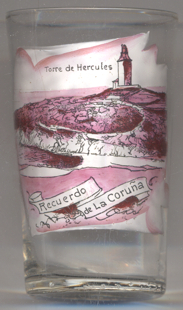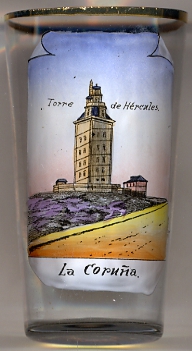

|
| ESPAÑA | Spain |
| Galicia | |
| Provincia da Coruña |
A Coruña (still sometimes known as Corunna in English, and archaically as The Groyne)
is the second-largest city in the autonomous community of Galicia and seventeenth overall in Spain. The city is the provincial capital of the province of the same name,
having also served as political capital of the Kingdom of Galicia from the 16th to the 19th centuries, and as a regional administrative centre between 1833 and 1982,
before being replaced by Santiago de Compostela.
 A Coruña spread from the peninsula where the Tower of Hercules stands, onto the mainland. The oldest part, known popularly in Galician as Cidade Vella (Old City), Cidade Alta (High City)
or the Cidade (City), is built on an ancient Celtic castro. It was supposedly inhabited by the Artabrians, the Celtic tribe of the area.
The Romans came to the region in the 2nd century BC, and the colonisers made the most of the strategic position and soon the city, then known as Brigantium, became quite important
in maritime trade. After the fall of the Roman Empire, A Coruña still had a commercial port connected to foreign countries, but contacts with the Mediterranean were slowly replaced by a
more Atlantic-oriented focus. In AD 991, king Vermudo II of Galicia began the construction of defensive military positions on the coast. At Faro, in the ruins of the Tower of Hercules,
a fortress was built, which had a permanent military garrison. To pay for it, he gave power over the city to the bishop of Santiago. The bishop of Santiago became the most important political post in Galicia, and remained so until the 15th century. In 1208, Alfonso IX re-founded the city of Crunia. Some privileges, such as those of disembarking and selling
salt without paying taxes, were granted to the city, and it enjoyed a big growth in fishing and mercantile business. The city grew and extended through the isthmus. In 1446 Juan II
of Castile granted to
A Coruña spread from the peninsula where the Tower of Hercules stands, onto the mainland. The oldest part, known popularly in Galician as Cidade Vella (Old City), Cidade Alta (High City)
or the Cidade (City), is built on an ancient Celtic castro. It was supposedly inhabited by the Artabrians, the Celtic tribe of the area.
The Romans came to the region in the 2nd century BC, and the colonisers made the most of the strategic position and soon the city, then known as Brigantium, became quite important
in maritime trade. After the fall of the Roman Empire, A Coruña still had a commercial port connected to foreign countries, but contacts with the Mediterranean were slowly replaced by a
more Atlantic-oriented focus. In AD 991, king Vermudo II of Galicia began the construction of defensive military positions on the coast. At Faro, in the ruins of the Tower of Hercules,
a fortress was built, which had a permanent military garrison. To pay for it, he gave power over the city to the bishop of Santiago. The bishop of Santiago became the most important political post in Galicia, and remained so until the 15th century. In 1208, Alfonso IX re-founded the city of Crunia. Some privileges, such as those of disembarking and selling
salt without paying taxes, were granted to the city, and it enjoyed a big growth in fishing and mercantile business. The city grew and extended through the isthmus. In 1446 Juan II
of Castile granted to

The  Tower of Hercules is an ancient Roman lighthouse on a peninsula about 2.4 kilometers from the centre.
Until the 20th century, the tower itself was known as the "Farum Brigantium". The structure is 55 metres tall and overlooks the North Atlantic coast of Spain.
The structure, almost 1900 years old and rehabilitated in 1791, is the oldest Roman lighthouse in use today.
The tower is known to have existed by the 2nd century, built or perhaps rebuilt under Trajan, possibly on foundations following a design that was Phoenician in origin.
It is thought to be modeled after the Lighthouse of Alexandria. At its base is preserved the cornerstone with an inscription permitting the original lighthouse tower to be ascribed to the
architect Gaius Sevius Lupus, from Aeminium (present-day Coimbra, Portugal) in the former province of Lusitania, as an offering dedicated to Mars. The tower has been in constant use since
the 2nd century and is considered to be the oldest existing lighthouse in the world. The earliest known reference to the lighthouse at Brigantium is found in a document written around 415/417.
In 1788, the original 34 metres, 3-storey tower was given a neoclassical restoration, including a new 21 metres fourth storey. The restoration was undertaken by naval engineer
Eustaquio Giannini and was finished in 1791. Within, the much-repaired Roman and medieval masonry may still be inspected.
The position of the lighthouse is not understood since it strongly favours an approach from the northwest. It does not provide a guide to safe harbour to vessels approaching either up the
West coast of the Iberian peninsula, nor along the Rias of the north coast. The position of the lighthouse is sufficiently far from Cape Finisterre to indicate that it was not built as a
marker for the end of the known earth. The Tower of Hercules was listed as a World Cultural Heritage site by UNESCO in 2009 (see also list of other
World Cultural Heritage sites depicted on glasses of this collection).
Tower of Hercules is an ancient Roman lighthouse on a peninsula about 2.4 kilometers from the centre.
Until the 20th century, the tower itself was known as the "Farum Brigantium". The structure is 55 metres tall and overlooks the North Atlantic coast of Spain.
The structure, almost 1900 years old and rehabilitated in 1791, is the oldest Roman lighthouse in use today.
The tower is known to have existed by the 2nd century, built or perhaps rebuilt under Trajan, possibly on foundations following a design that was Phoenician in origin.
It is thought to be modeled after the Lighthouse of Alexandria. At its base is preserved the cornerstone with an inscription permitting the original lighthouse tower to be ascribed to the
architect Gaius Sevius Lupus, from Aeminium (present-day Coimbra, Portugal) in the former province of Lusitania, as an offering dedicated to Mars. The tower has been in constant use since
the 2nd century and is considered to be the oldest existing lighthouse in the world. The earliest known reference to the lighthouse at Brigantium is found in a document written around 415/417.
In 1788, the original 34 metres, 3-storey tower was given a neoclassical restoration, including a new 21 metres fourth storey. The restoration was undertaken by naval engineer
Eustaquio Giannini and was finished in 1791. Within, the much-repaired Roman and medieval masonry may still be inspected.
The position of the lighthouse is not understood since it strongly favours an approach from the northwest. It does not provide a guide to safe harbour to vessels approaching either up the
West coast of the Iberian peninsula, nor along the Rias of the north coast. The position of the lighthouse is sufficiently far from Cape Finisterre to indicate that it was not built as a
marker for the end of the known earth. The Tower of Hercules was listed as a World Cultural Heritage site by UNESCO in 2009 (see also list of other
World Cultural Heritage sites depicted on glasses of this collection).
[http://en.wikipedia.org/wiki/A_Coruña; https://de.wikipedia.org/wiki/A_Coruña; http://en.wikipedia.org/wiki/Tower_of_Hercules]
![[scale]](lineal.jpg)